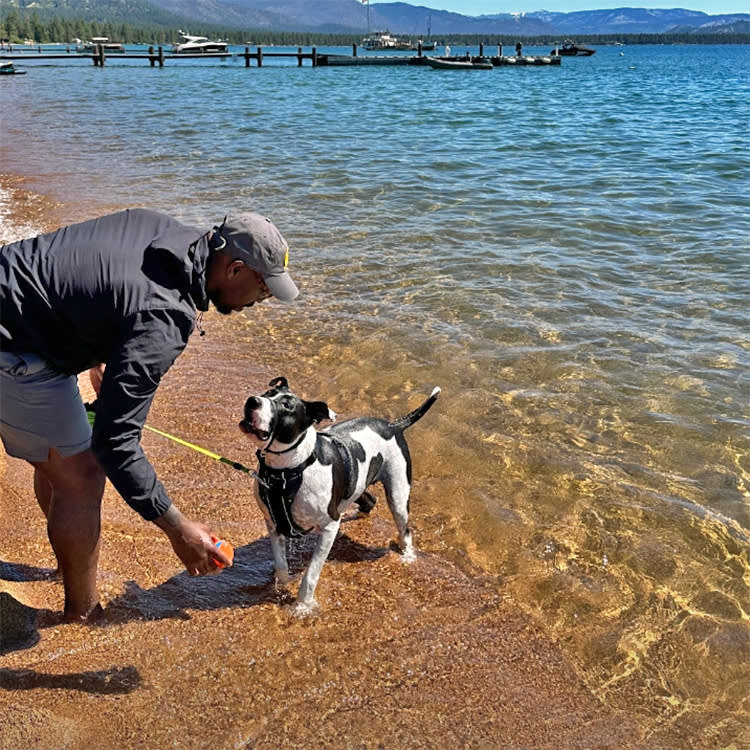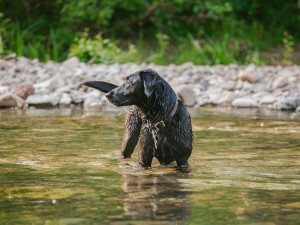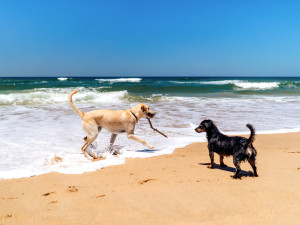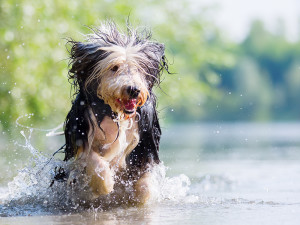2 Dogs Reportedly Died From Blue-Green Algae Last Week
Everything you need to know to keep your pup safe.

Share Article
Last week, one TikTok user, Anaïs Felt, posted a heartbreaking videoopens in a new tab to raise awareness about a deadly summertime threat to dogs. In it, she shared that she took her dog, Cora, swimming at Lake Tahoe’s El Dorado Beach, and “within an hour she was very sick, and within three hours she had passed away.”
The veterinarians at an emergency hospital told her that Cora had ingested blue-green algae, a toxin-producing cyanobacteria. The animal hospital alerted the USDA Forest Service and National Forest Supervisors. Lahontan Regional Water Quality Control Board performed a site checkopens in a new tab on Monday that did not identify visual signs of blue-green algae, and they are waiting for results from tests which will likely come back within the week. In the meantime, the City of South Lake Tahoe has added caution signs to the beaches, warning visitors that the water may contain the toxic substance.

Get (totally free) deals for food, treats, accessories, tech, and way more pet parenting must-haves.
opens in a new tabThis is the time of year when blue-green algae typically makes an appearance. “They thrive in warm, nutrient-rich waters, especially during the summer months,” veterinarian Dr. Alex Crowopens in a new tab tells us. Blue-green algae has recently been found in water sources across the country, from New Yorkopens in a new tab to Southern California.opens in a new tab A dog in Texas recently diedopens in a new tab after swimming in Lake Travis; tests are being conducted to confirm whether the death was caused by blue-green algae.
Blue-green algae can show in the water as discoloration and scum when it blooms, but it’s not always visible to the naked eye. When Felt took Cora for a swim, the water was extremely clear, and many dogs and people were wading. She posted her video to warn people against taking their dogs swimming in Lake Tahoe — because once dogs have ingested blue-green algae, there’s no cure. “The doctors were amazing. They did everything they could to save her,” Felt said. “Our lives will never be the same. She was the heart and soul of our family and we miss her so much.”
The dangers of blue-green algae
Blue-green algae is a microscopic organism that can be found in a variety of water sources, including freshwater lakes, ponds, and streams, Dr. Crow explains. Any dog who comes into contact with water that contains blue-green algae is at risk of getting sick. “For dogs, exposure often occurs when they drink contaminated water, lick their fur after swimming, or even inhale water droplets from an algal bloom,” Dr. Crow says.
All animals, including cats and humans, can be harmed by blue-green algaeopens in a new tab — but dogs are at especially high risk, since cats are less likely to swim and pickier about what water they drink. In humans, blue-green algae causes symptomsopens in a new tab including numbness, dizziness, vomiting, and abdominal pain but is not fatal.
Once ingested, blue-green algae is extremely dangerous. Many species of the cyanobacteria produce toxins that affect the liver, nervous system, and skin — this can happen within minutes to hours. “Liver toxins can cause symptoms such as vomiting,opens in a new tab diarrhea,opens in a new tab blood in the stool or vomit, weakness, and jaundice,” Dr. Crow says. “Neurotoxins can lead to more immediate and severe symptoms like drooling, muscle tremors, difficulty breathing, seizures,opens in a new tab and even sudden death.”
If your pet shows symptoms or you think they may have ingested water containing blue-green algae, it’s important to get them to a veterinarian as soon as possible. “Detecting blue-green algae exposure can be challenging because the symptoms are often non-specific and can resemble other conditions,” Dr. Crow says. Diagnostic tests, clinical signs, and exposure history can help vets make their diagnosis. Though there’s no cure for blue-green algae poisoning, vets can help manage a pet’s symptoms.
How to keep pets safe from blue-green algae
When blue-green algae multiplies, it can appear to the naked eye as “algal blooms that appear as greenish, blue, or brown scum on the water’s surface,” Dr. Crow says. Pet parents should avoid areas where they see signs of blue-green algae.
In general, stagnant water should be avoided as much as possible, Dr. Crow adds. “During warm months, avoid letting your dog swim or drink from stagnant bodies of water, especially if you notice greenish scum on the surface.”
Take note of any local advisories and research a body of water before you bring your dog. “Many communities monitor water bodies for harmful algal blooms and issue warnings when levels are unsafe,” Dr. Crow says.
Keep an eye on your dog any time they’re outdoors to be sure they aren’t ingesting water from an unknown source. If you take your dog swimming, Dr. Crow recommends rinsing them off with clean water as soon as possible after they get out.

Sio Hornbuckle
Sio Hornbuckle is a writer living in New York City with their cat, Toni Collette.
Related articles
![Shepherd dog playing with yellow ball at the beach]() opens in a new tab
opens in a new tabHow to Keep Your Dog Safe at the Beach This Summer
5 tips to help your pup have fun in the sun — safely.
![Black Lab playing in creek]() opens in a new tab
opens in a new tabWhy You Should Stay Far, Far Away From Blue-Green Algae This Summer
Consider getting a water-testing kit to keep your pup safe.
![A woman checking out her dogs paw.]() opens in a new tab
opens in a new tabHere’s Where Disease-Carrying Ticks Are in the US—And How to Keep Your Pup Safe
Simple preventive steps can go a long way toward offsetting their threats.
![Labrador Retriever and Dachsund playing with a stick at the beach shoreline]() opens in a new tab
opens in a new tabSummer Is Heating Up. Here Are 6 Ways to Keep Your Dog From Doing the Same
Pro tips to keep your pup safe, happy, and exercised during the warmer months.
![Owner and their dog outside in the summer.]() opens in a new tab
opens in a new tabIt’s Hot Out There—Here’s How You Can Protect Your Pup’s Paws
Those perfect little toe beans need all the help they can get.
![Bearded Collie running in a lake]() opens in a new tab
opens in a new tabWhen Drinking Too Much Water Is Deadly
How to keep your swim fan safe.







